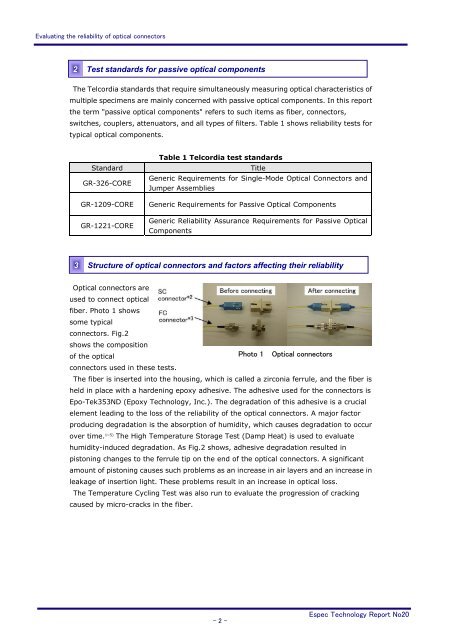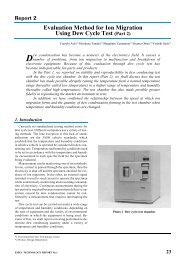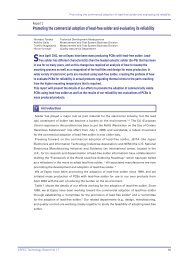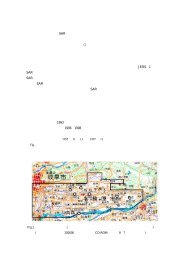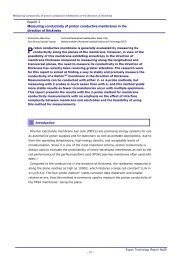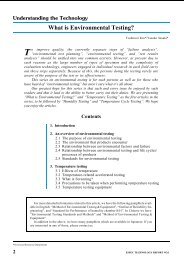Evaluating the reliability of optical connectors
Evaluating the reliability of optical connectors
Evaluating the reliability of optical connectors
Create successful ePaper yourself
Turn your PDF publications into a flip-book with our unique Google optimized e-Paper software.
<strong>Evaluating</strong> <strong>the</strong> <strong>reliability</strong> <strong>of</strong> <strong>optical</strong> <strong>connectors</strong><br />
2<br />
The Telcordia standards that require simultaneously measuring <strong>optical</strong> characteristics <strong>of</strong><br />
multiple specimens are mainly concerned with passive <strong>optical</strong> components. In this report<br />
<strong>the</strong> term "passive <strong>optical</strong> components" refers to such items as fiber, <strong>connectors</strong>,<br />
switches, couplers, attenuators, and all types <strong>of</strong> filters. Table 1 shows <strong>reliability</strong> tests for<br />
typical <strong>optical</strong> components.<br />
3<br />
Test standards for passive <strong>optical</strong> components<br />
Table 1 Telcordia test standards<br />
Standard Title<br />
GR-326-CORE<br />
Generic Requirements for Single-Mode Optical Connectors and<br />
Jumper Assemblies<br />
GR-1209-CORE Generic Requirements for Passive Optical Components<br />
GR-1221-CORE<br />
Generic Reliability Assurance Requirements for Passive Optical<br />
Components<br />
Structure <strong>of</strong> <strong>optical</strong> <strong>connectors</strong> and factors affecting <strong>the</strong>ir <strong>reliability</strong><br />
Optical <strong>connectors</strong> are<br />
used to connect <strong>optical</strong><br />
fiber. Photo 1 shows<br />
some typical<br />
<strong>connectors</strong>. Fig.2<br />
shows <strong>the</strong> composition<br />
<strong>of</strong> <strong>the</strong> <strong>optical</strong><br />
<strong>connectors</strong> used in <strong>the</strong>se tests.<br />
The fiber is inserted into <strong>the</strong> housing, which is called a zirconia ferrule, and <strong>the</strong> fiber is<br />
held in place with a hardening epoxy adhesive. The adhesive used for <strong>the</strong> <strong>connectors</strong> is<br />
Epo-Tek353ND (Epoxy Technology, Inc.). The degradation <strong>of</strong> this adhesive is a crucial<br />
element leading to <strong>the</strong> loss <strong>of</strong> <strong>the</strong> <strong>reliability</strong> <strong>of</strong> <strong>the</strong> <strong>optical</strong> <strong>connectors</strong>. A major factor<br />
producing degradation is <strong>the</strong> absorption <strong>of</strong> humidity, which causes degradation to occur<br />
over time. 1~5) Photo 1 Optical <strong>connectors</strong><br />
The High Temperature Storage Test (Damp Heat) is used to evaluate<br />
humidity-induced degradation. As Fig.2 shows, adhesive degradation resulted in<br />
pistoning changes to <strong>the</strong> ferrule tip on <strong>the</strong> end <strong>of</strong> <strong>the</strong> <strong>optical</strong> <strong>connectors</strong>. A significant<br />
amount <strong>of</strong> pistoning causes such problems as an increase in air layers and an increase in<br />
leakage <strong>of</strong> insertion light. These problems result in an increase in <strong>optical</strong> loss.<br />
The Temperature Cycling Test was also run to evaluate <strong>the</strong> progression <strong>of</strong> cracking<br />
caused by micro-cracks in <strong>the</strong> fiber.<br />
- 2 -<br />
Espec Technology Report No20


